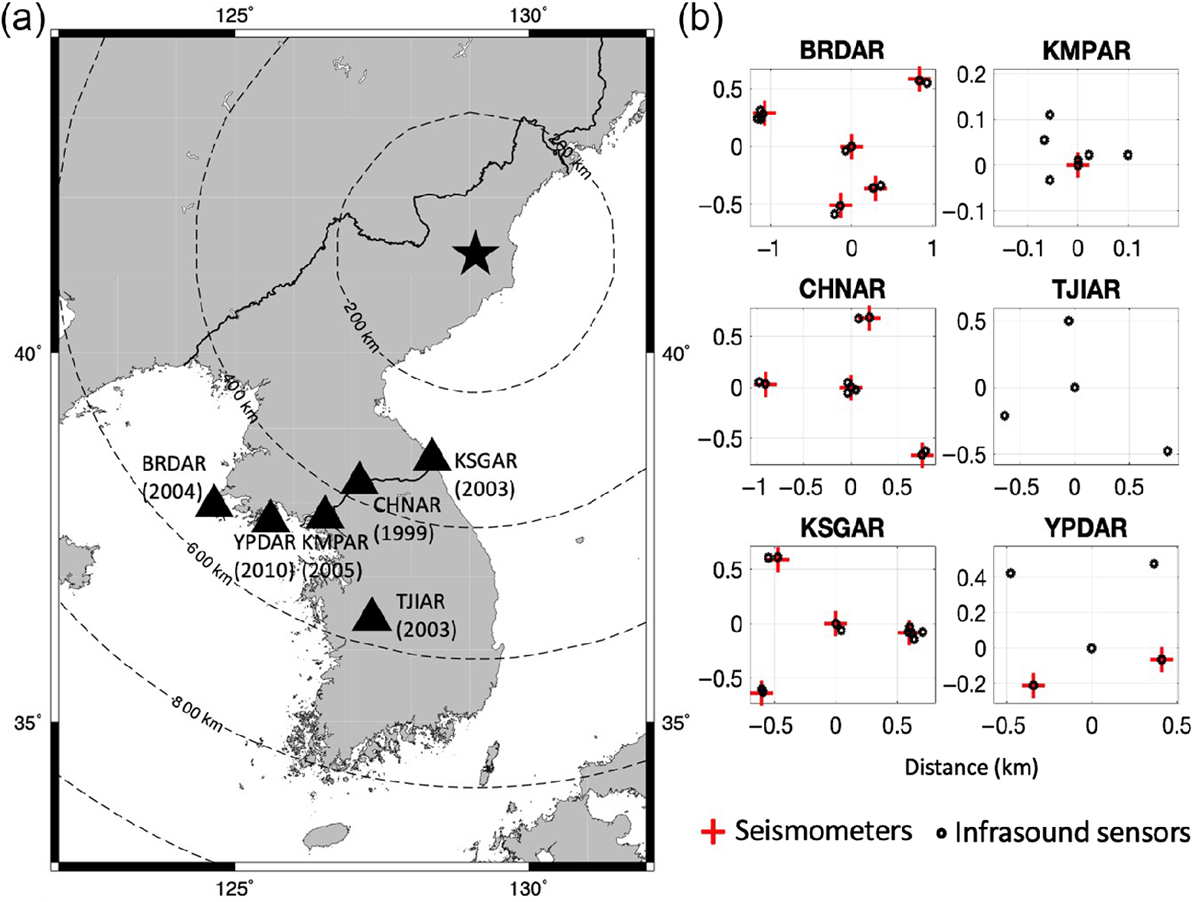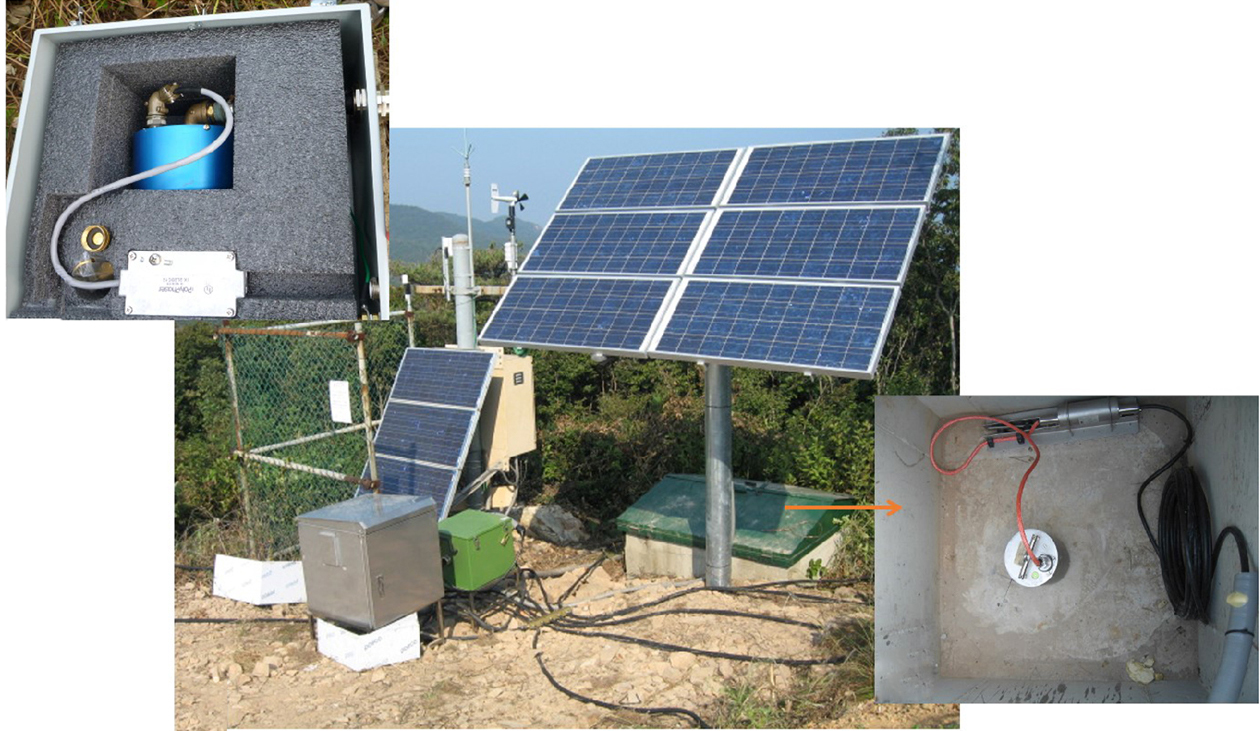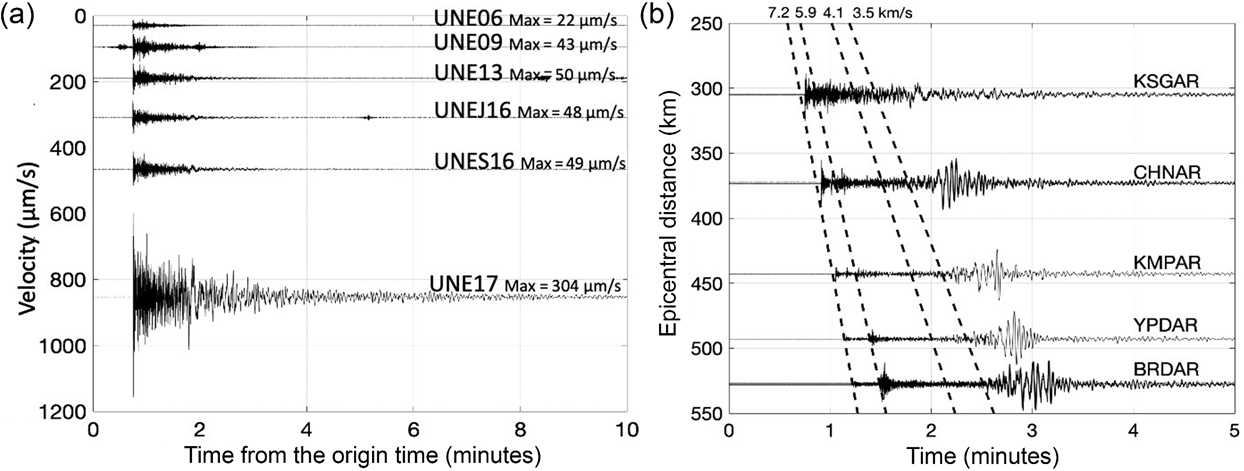Figure 1 (a) Locations of the nuclear test site (star) in Democratic People’s Republic of Korea (DPRK) and the seismoacoustic research arrays, BRDAR, CHNAR, KSGAR, KMPAR, TJIAR, and YPDAR, across the southern Korean peninsula. The installation year of each array is given in parenthesis. (b) The geometry of each array illustrates the locations of individual seismometers and infrasound sensors.
Summary
Global monitoring of nuclear explosions requires a range of datasets including seismic, infrasound, hydro-acoustic and radionuclide. The International Monitoring System (IMS) operated by the Comprehensive Nuclear‐Test‐Ban‐Treaty Organization (CTBTO) consists of 337 globally distributed facilities and is expected to identify small events exceeding M4.0.
Over the past twenty years, arrays in South Korea operated jointly between Southern Methodist University (SMU) and Korea Institute of Geoscience and Mineral Resources (KIGAM) that combine seismic and infrasound sensors have improved monitoring of nuclear testing in the neighbouring Democratic People’s Republic of Korea (DPRK). The ‘seismo-acoustic’ arrays are found to be particularly useful in discriminating human-induced events from natural earthquakes as they provide higher signal to noise ratio (SNR) data and also greater sensitivity to higher frequency data to assist with source characterization.
Array Design
The initial arrays consisted of single axis (vertical) short period seismometers and limited infrasound sensors. In 2011 the arrays were upgraded by SMU to include between one and five triaxial Güralp 3T seismometers with a larger number of infrasound sensors. The weak-motion 3T seismometer provides exceptionally high quality monitoring over the long-period.
The seismo-acoustic stations collocate the 3T seismometer with infrasound sensors across multiple arrays. The colocation of both instruments allows for a better understanding of how energy from the underground nuclear explosion (UNE) propagates through the solid earth and atmosphere and how these travel times and paths compare.
The Güralp Solution
Güralp instrumentation
The 3T instrument included an integrated digitizer and high pressure connector to allow for posthole deployments. The sensors were also specifically tuned in the factory with a 2x 10,000 V/m/s sensitivity to allow for very high signal to noise ratio (SNR) data to be recorded for smaller events.
Supplied by Güralp as a turnkey system, in addition to the 3T, each seismic station included a weather-station, network authentication, a universal control box, solar panels, backup power, WiFi and Radio comms.
The bespoke universal control boxes act as an effective tool for data acquisition from the various other auxiliary sensors at the sites, including weather stations, as well as providing backup power to the systems. The engineered boxes are designed to be weatherproof and robust to protect the contents from rain and snow.
All equipment underwent a factory acceptance test before shipment to ensure that equipment met the monitoring standard required. Güralp engineers worked closely with SMU to provide a solution that would effectively integrate the various systems in terms of data acquisition, transmission and power management.
The sensors were deployed in a mix of shallow vaults and posthole (~10m deep) installations to aid with SNR. A Güralp engineer was present for the deployments in 2011 and helped to integrate the systems.
Figure 2 Example station set-up (Top) Infrasound and lightning protection. (Middle) station set up including digitiser, infrasound sensor with porous hose noise reduction system, seismometer in the vault, battery and telemetry equipment inside the enclosures, weather sensors, Global Positioning System and telemetry antennas, and solar panels. (Right) 3T seismometer in vault.
Outcome
The presence of regional monitoring arrays in closer proximity to the test site has also recorded higher signal-to-noise ratio data which in turn has contributed to better resolution of both propagation path and source effects, thus enhancing separation of these contributions. This data is being made available for researchers interested in further studying and quantifying the explosion characteristics.
The work will benefit the global IMS community through the availability of co-located seismic and acoustic data from six known UNEs conducted by DPRK. The data is crucial for estimating event location and yield, thereby contributing greatly to future nuclear test monitoring efforts and global security.
Figure 3 Unfiltered vertical velocity seismograms from the six explosions recorded at KSGAR (KSG31). Maximum amplitudes are denoted to the right of each waveform. (b) The vertical record section of normalized waveforms (unfiltered data) from the sixth explosion on 9 September 2017, recorded at BRDAR, YPDAR, KMPAR, CHNAR, and KSGAR. Group velocities for Pn, Pg, Sn, and Lg phases displayed are from the International Association of Seismology and Physics of the Earth’s Interior (IASPEI) model and delineated as dashed lines for comparison purposes.
References
All figures courtesy of Brian Stump, Christopher Hayward, Paul Golden, Junghyun Park, Ray Kubacki, Chris Cain, Stephen Arrowsmith, Mihan H. McKenna Taylor, SeongJu Jeong, Tina Ivey, Mason MacPhail, Cathy Chickering Pace, Jeong‐Soo Jeon, Il‐Young Che, Kwangsu Kim, Byung‐Il Kim, Tae‐Sung Kim, In‐Cheol Shin, Myung‐Soon Jun; Seismic and Infrasound Data Recorded at Regional Seismoacoustic Research Arrays in South Korea from the Six DPRK Underground Nuclear Explosions. Seismological Research Letters 2022;; 93 (4): 2389–2400. doi: https://doi.org/10.1785/0220220009




